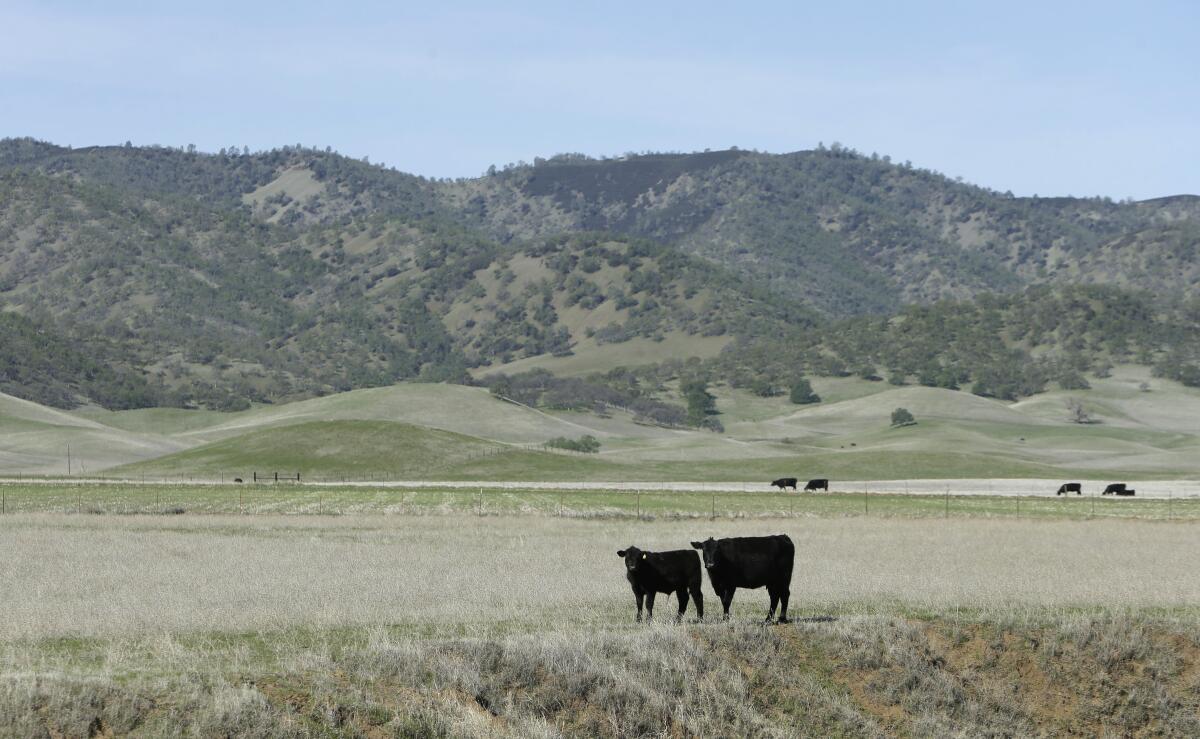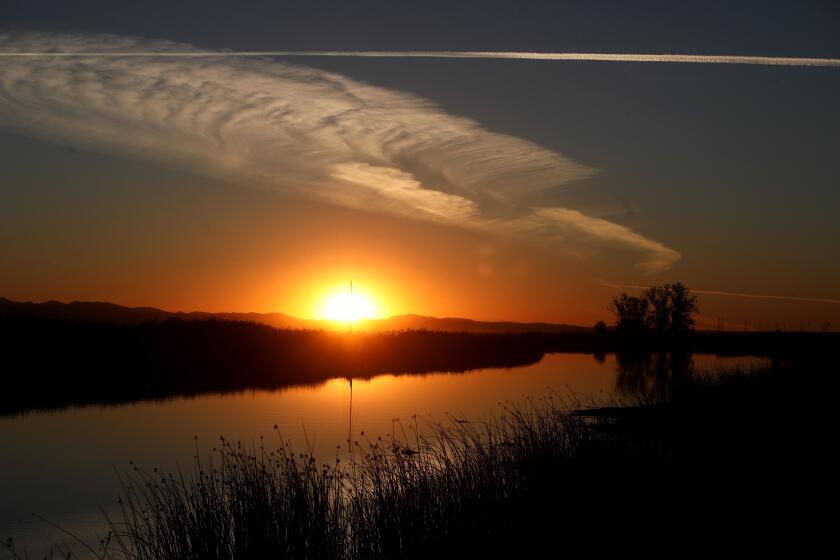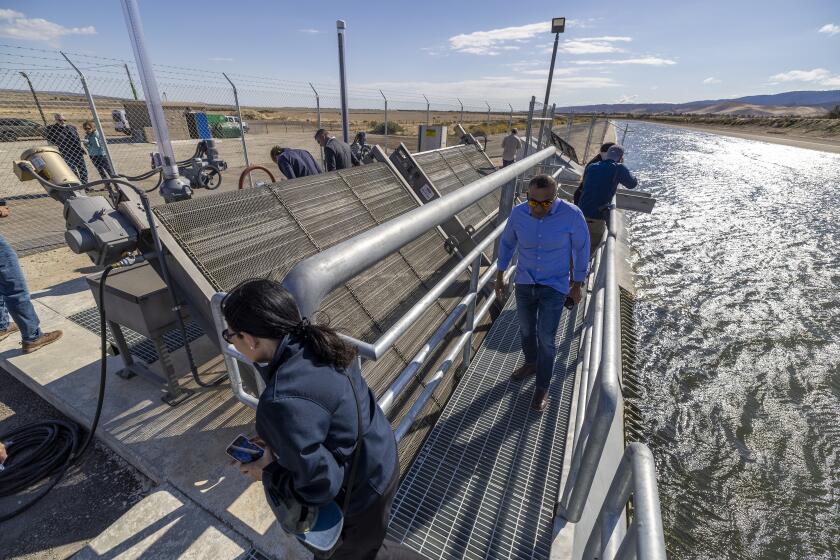Column: It’s about time California built the Sites Reservoir

- Share via
SACRAMENTO — California’s state government began drawing up plans for Sites Reservoir in the Sacramento Valley 70 years ago. And it still only exists on paper.
So, kudos to Gov. Gavin Newsom for deciding that it’s finally time to put this tardy project on the fast track.
Fast track means there’ll be limited time for any opponent to contest the project in court on environmental grounds.
Newsom used a new law he pushed through the Legislature in June aimed at making it easier to build transportation, clean energy and water infrastructure by expediting lawsuits under the California Environmental Quality Act.
‘Most of this water is not just uncaptured — it’s uncapturable,’ Greg Gartrell, a delta expert at the Public Policy Institute of California, tells George Skelton.
Sites is the first project to be fast-tracked.
It will be the biggest dam built in California in roughly a half century, since 1979, when the federal government completed New Melones in Calaveras County.
It’ll also be the first major dam constructed since 1999 when the Metropolitan Water District of Southern California finished Diamond Valley in Riverside County.
Much of the public — especially agriculture interests and Republican politicians — has complained for years about California not building more dams. Now, it looks like a sizable new reservoir will actually be built.
Sites, located on present grazing land in Colusa and Glenn counties 70 miles north of Sacramento, could hold 1.5 million acre-feet of water, enough to annually serve 3 million homes. It will be California’s eighth-largest reservoir.
This will be an off-stream reservoir, siphoning water off the nearby Sacramento River.
The idea is to take the water during high river flows — particularly during flood threats — and hold it until river water is low. Then the diverted water will be released back into the river and end up in southbound aqueducts out of the Sacramento-San Joaquin River Delta. It’ll be delivered to farmers and city folks.
But it’s a bum rap to blame the state government for not building more dams in California.
We’ve got a boatload of reservoirs — nearly 1,500. Roughly 1,000 are major.
Virtually every river worth damming already has been. We’ve about run out of feasible locations. There’s a safety problem: The state is riddled with earthquake faults.
We’re also a lot more concerned today about environmental damage than we were during our dam-building binge in the mid-20th century.
And many northerners have had it with Southland cities and corporate agriculture trying to tap into more north state water. That’s especially true around the delta, where salmon runs have declined dramatically in recent decades because of water being pumped south.
So, Sites probably will be the last reservoir of its size — or anywhere near it — built in California.
We need to continue cutting back on water use. That means, among other things, fallowing between 500,000 and 900,000 acres of San Joaquin Valley cropland during the next two decades, experts say. Agriculture uses 80% of California’s developed water and exports much of its crops overseas.
Plant solar panels instead.
Also sorely needed is more groundwater cleanup and recharge, urban stormwater capture and recycling. Governments at all levels have been spending billions on those endeavors.
Sites, however, looks like a worthy project.
As an off-stream reservoir, it won’t block salmon trying to spawn upriver as do many big dams such as Shasta, Oroville and Folsom.
Besides supplying irrigation water during summer, it will provide flood control in winter. If run right, it can help manage flows for migrating salmon.
There’ll be boating, fishing and camping.
But some environmental groups object. They mainly just don’t like dams.
The Sites Reservoir plan would flood a bucolic valley north of Sacramento. Environmentalists say it would do little to solve California’s water woes.
“Building new dams and reservoirs is an idea of the past,” says Erin Woolley, senior policy strategist for the Sierra Club. “California should be permitting other projects that do not have environmental costs.”
For one thing, Woolley fears that releasing stagnant water back into the Sacramento River after it has been stored in a warm summer pool will raise river temperatures. That would be bad for fish and add to toxicity and algae in the delta, she says.
Woolley also points to recent research showing that reservoirs emit substantial amounts of methane, a potent greenhouse gas. “Sites would have significant greenhouse gas emissions,” she says.
OK, too bad! We need water for drinking, bathing and growing food. It’s a necessary tradeoff. Fossil fuel is the big greenhouse gas culprit, not reservoir water.
Anyway, the project intends to minimize emissions, says Sites executive director Jerry Brown — no relation to the former governor who lives nearby on his family’s ancestral ranch.
No, the ex-governor won’t have lakefront property.
There’s some public confusion about whose project this is. It’s not the state’s. The state originally planned a much larger reservoir but dropped the idea. It was picked up and downsized by local water districts and counties.
The projected cost is $4.5 billion, most of it to be paid by water users, including Angelenos. Southern California’s MWD plans to buy 20% of the water.
The state has committed $875 million for “public benefits” — environmental protection, flood control and recreation. It comes from a $7.5-billion water bond — $2.7 billion of it for water storage — crafted by Gov. Brown and passed by voters in 2014.
The feds also are kicking in big money.
A new water storage facility in the desert will bank supplies underground for Southern California in an effort to help the region adapt to climate change.
Project director Brown expects that, in the next two years, state and federal regulatory agencies will grant the necessary permits and construction will begin in 2026 with completion in 2032.
Under fast tracking, the goal is to wrap up any environmental lawsuits in 270 days — at least within a year. That’s expected to cut years off project development and save hundreds of millions of dollars.
Whatever. It’s bound to be faster than 70 years.
More to Read
Sign up for Essential California
The most important California stories and recommendations in your inbox every morning.
You may occasionally receive promotional content from the Los Angeles Times.














